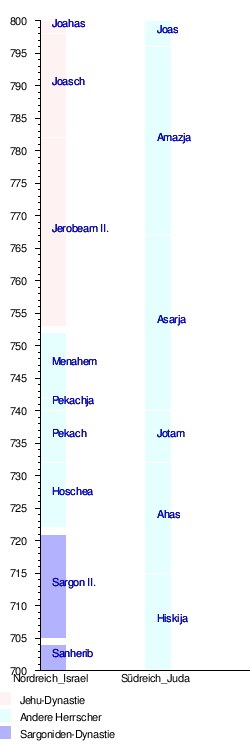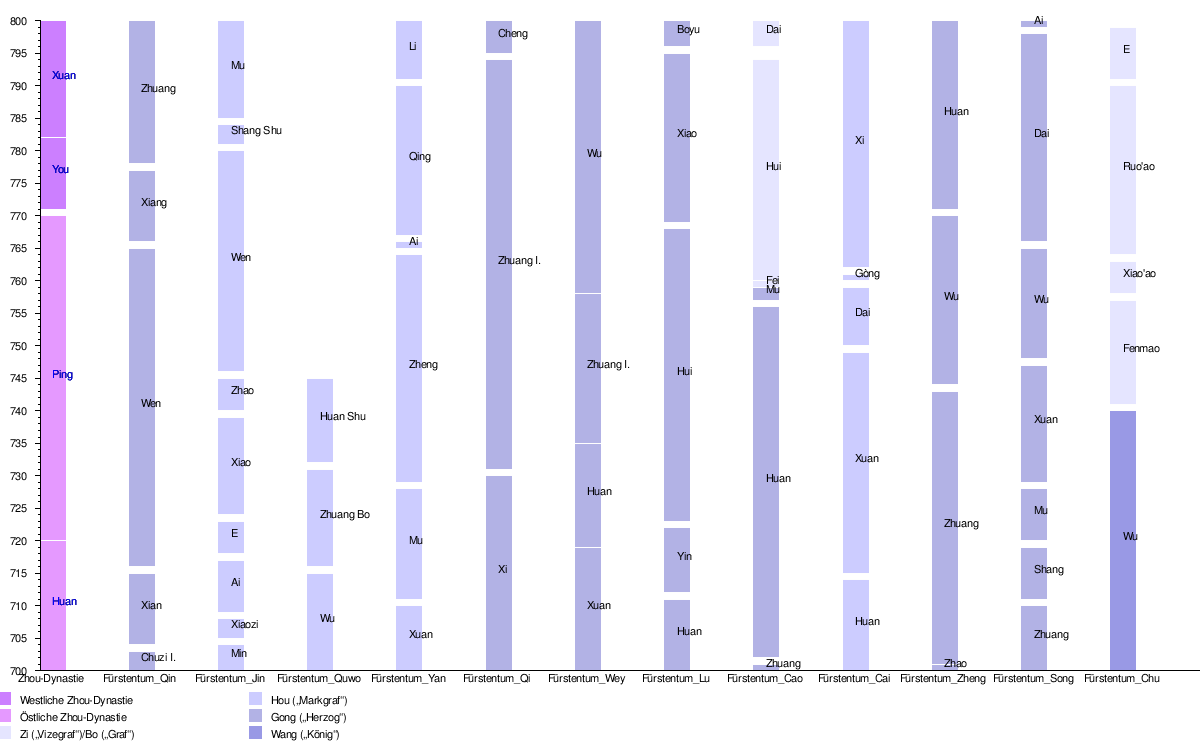List of rulers in the 8th century BC Chr.
Overview
10th century BC Chr. | 9th century BC Chr. | List of rulers in the 8th century BC Chr. | 7th century BC Chr. | 6th century BC Chr.
More events
This is a synchronous representation of the reigns of early ancient rulers in the 8th century BC , visualized in the form of equally scaled timelines.
Africa / Egypt
Middle East


China
Remarks
On Nabu-nadin-zeri followed 731 v. BC Nabû-šuma-ukīn II , who reigned only one month and is not listed above.
Before Marduk-apla-iddina II's second term in office , Marduk-zakir-šumi II ruled for one month, not listed above.
Of the Chinese states of the spring and autumn annals , only the larger principalities are listed.
For the period 800-700 BC, there are further details about rulers that are not listed here for various reasons. These include mythical ancestral kings, but also rulers, who cannot be precisely fixed in time. See, for example, the lists of the kings of Ireland , Carthage , Rome , Lydia , Byblos , Tire , Aram , Moab , Argos , Sparta , Corinth , Vietnam , Korea .
Deputies and viceroys are only listed here if the territory they administer formed an independent state before or afterwards. Exceptions are the kingdoms of Judah and Israel, which were tributary but are of particular interest due to the Old Testament . For their dating see the corresponding king list .
General
In the timeline, a gap of one year symbolizes that the transition between two rulers will be assumed around this time. If the transition period can be determined more precisely, this is indicated by a thinner line. Larger gaps between two names do not necessarily mean that there was no ruler; but indicate an uncertainty. If no colored bars are displayed, the relevant rulers cannot be dated more precisely according to the latest research. The representation does not claim to be complete.
Specifically, the dating according to Nissen (2012) is used here for the information on ancient oriental kings and the dating according to Beckerath (1994) for the information on Egyptian kings.
General note: The dates of this list have not been finalized, see also ancient oriental and Egyptian chronology. Depending on the opinion of an author, the dating of great kings and pharaohs during this period can differ by several years from the information used here, and significantly more for even earlier periods. Specialist authors often state which assumptions / chronologies their writings are based on.
Due to new archaeological findings, the state of research and current doctrine on dating can occasionally change abruptly. If more recent findings are incorporated, the simultaneity of rulers must be checked (this should be guaranteed according to archaeological evidence) and the chronology used and the source / place of discovery must be indicated.
Individual evidence
- ^ Hans Jörg Nissen : History of the ancient Near East . Oldenbourg Verlag, 2nd edition 2012, Munich. ISBN 3-486-59223-8 .
- ↑ Jürgen von Beckerath : Chronology of the Pharaonic Egypt. The timing of Egyptian history from prehistoric times to 332 BC BC (= Munich Egyptological Studies . Vol. 46). von Zabern, Mainz 1997.







